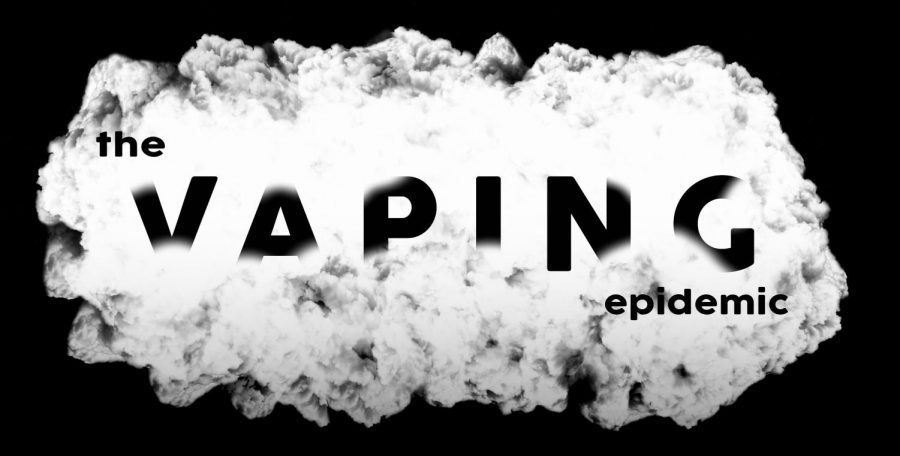The vaping epidemic: The reckoning has arrived and e-cigarette users are facing deadly consequences
November 13, 2019
18 deaths in 15 states in just three months; one of those states being Nebraska. 1,080 patients with vaping-related illnesses — 16 percent of those being under the age of 18.
Within the past six months, vaping-related illnesses have dominated the news cycle. It’s as though there is a new respiratory illness or death each week. Health professionals, health agencies and the general public have been scrambling to wrap their heads around what this outbreak of lung injury associated with vaping is truly about.
WHAT WE KNOW:
“These products are highly unregulated, and we have no definitive knowledge of the diversity of chemicals that people are inhaling,” Dr. Tom Safranek, Nebraska state epidemiologist, said in a September 2019 Lincoln Journal Star article.
Vaping hasn’t been around long enough for us to know how it truly affects the body over time, but it is apparent that there are serious health repercussions to regular users of electronic cigarettes (e-cigarettes).
Vaping is the inhalation of vapor created by an e-cigarette, or other vaping device. E-cigarettes are battery-powered smoking devices that have cartridges filled with a liquid that usually contains nicotine, flavorings and chemicals. The liquid is heated into a vapor that the person inhales — that’s why using e-cigarettes is called vaping.
E-cigarettes were originally created to help cigarette smokers quit smoking, but they have recently taken on a nuanced purpose. More and more teens are starting to vape. One of the most infamous companies known for targeting teenagers is Juul. Juul was founded in 2015, and in their first few years Juul would specifically target advertisements to teenagers.
It is not uncommon today to walk into the school bathroom (also known as “the Juul room”) and smell hints of mango or mint after a puff of vapor floats above the handicap stall, or for teachers to jokingly say to students heading to the bathroom, “Don’t take your Juul with you!”
A generation that had potential to effectively stop the smoking epidemic has now buried themselves into a much more complicated, uncertain and vapor-filled hole. They’ve gotten themselves hooked on a USB-looking device that could very well result in their death, far quicker than cigarettes.
Although the Juul appears to be the main culprit of vaping-related illnesses, there are a multitude of different “vapes” that people are using: Novo, Blu, Suorin drop, Air and many more.
Though there is a lot of information flying around, here are key facts that contribute to the sudden coverage of these illnesses and deaths according to the Centers for Disease Control and Prevention (CDC):
- All reported patients have a history of e-cigarette product use or vaping.
- Many patients experienced a combination of similar symptoms to that of pneumonia: coughing, trouble breathing, chest pain, extreme fatigue, vomiting and diarrhea.
- The latest findings from the investigation into lung injuries associated with e-cigarette use, or vaping, suggest products containing THC (the principal psychoactive constituent of cannabis) play a role in the outbreak.
- The liquid inside e-cigarettes can contain nicotine, cannabinoid (CBD) oils or other substances and additives.
The CDC received data on the substances used in e-cigarettes or vaping products in the 30 days prior to 514 patients experiencing symptoms, and found that about 77 percent reported using THC-containing products, 36 percent reported exclusive use of THC-containing products, 57 percent reported using nicotine-containing products and 16 percent reported exclusive use of nicotine-containing products.
While this data points toward blaming THC-containing products for these illnesses, it is not the sole cause. Nicotine may seem less consequential compared to THC in this data, but there are still negative effects linked to using nicotine.
According to The Washington Post, pediatricians report seeing teenagers behave less like tobacco users and more like substance-abuse disorder patients.
“With the Juuls, kids are able to get a much higher dose of nicotine — and dose matters,” Sharon Levy, director of the Adolescent Substance Use and Addiction Program at Boston Children’s Hospital, said to The Washington Post. “These kids have behaviors we often see in patients who have opioid or marijuana addiction; we didn’t typically see [this] with kids who developed [an] addiction to traditional tobacco cigarettes.”
VAPING IN NEBRASKA:
Nebraska is one of the handful of states where there has recently been a death related to severe lung disease associated with e-cigarettes or vaping. According to the Lincoln Journal Star, Nebraska currently has 11 cases of vaping-related illness, and two are under investigation. The majority are men who range in age from their late teens to 60s; some of those were hospitalized.
Health and Human Services advised Nebraska providers to take vaping-related illnesses into consideration in patients seeking treatment for respiratory symptoms and who have a history of vaping.
WHAT WE DON’T KNOW:
One of the most uncertain aspects of vaping is the specific chemical exposures causing these lung injuries. No single product or substance has been linked to all lung injury cases. According to the CDC, more information is needed to know whether one or more e-cigarette or vaping products, substances or brand is responsible for the outbreak.
Health care providers are unsure of how to diagnose a patient with a vaping-related illness. It’s difficult to narrow down a specific cause when an e-cigarette user has the same symptoms as Pneumonia or another common respiratory illness.
Safranek issued an alert on Sept. 3 to health care providers to consider vaping-related illnesses when patients come in with respiratory symptoms and a history of vaping.
“For the most part, the body recovers on its own, with help, once the toxins are removed and the air breathed is as clean as possible,” Safranek said. “But it’s unclear what the long-term defects or impairment of the lungs might be from the illness.”
According to NPR, investigators in New York reported on findings of vitamin E acetate in samples of products handed over by some patients early on during the outbreak. The Food and Drug Administration (FDA), which is also collecting samples from patients, has found vitamin E acetate, too. The agency said its investigation is ongoing and the results are preliminary. So far, it has not been able to pinpoint an exact product or compound linked to all cases.
WHAT WE SHOULD DO:
The best way to prevent a vaping-related illness is to stop vaping. With all the uncertainty of the causes and chemicals being inhaled by these products, anyone that vapes or uses e-cigarettes should consider quitting if they fear of contracting an illness — which could lead to death.
Students at Lincoln Southeast High School have already taken that step.
“I’m throwing all my broken [e-cigarettes] into the lake, and I got rid of all my juice,” John* said. “I can’t fill it up as often as I usually would; it declines the amount that I use it so I’m slowly quitting.”
John has been vaping for nearly two years. Before he first started, he didn’t use it at all, but after seeing his friends and his brother vaping, he decided to start as well.
Though the outbreak didn’t necessarily compel him to quit, he said he wasn’t aware of the consequences linked to vaping when he started.
“[I wasn’t aware of] the extent [the consequences] are now, because when I first started it had just come out so there hadn’t been any research or anything on them,” John said.
Similar to John, Katie* has also been vaping for two years and has decided to get rid of her vape.
As with most teenage users of vapes, Katie got into vaping through an older source. She said that she and her friend would see an older brother vaping when they would hang out, so they started vaping as well.
She said that the reason all of this news about vaping is coming out now is because, “It’s the same with cigarettes,” and it took 40 years for people to figure out why smoking was bad for them.
“We just figured it out faster,” Katie said.
As with John, Katie got rid of her vape out of respect for her mother’s request. She ran over it with her car and threw it away, claiming that she would have done that for her mom even if she wasn’t panicked about the news.
“I think she [asked me to get rid of] it because of [the news],” Katie said. “But she also wanted me to stop, so it was a combination [of both].”
While there is still much to be learned about vaping and its effects on a person’s health, this outbreak should not be taken lightly… Yes, a majority of patients used THC-containing products, and yes, a majority of patients are not high schoolers, but teenagers are not immune to these illnesses solely because they are young.
Do not wait to quit until there is a personal experience of vaping-related illness. Be proactive. Do not make choices in high school that you will later regret; the future is still very unknown.










